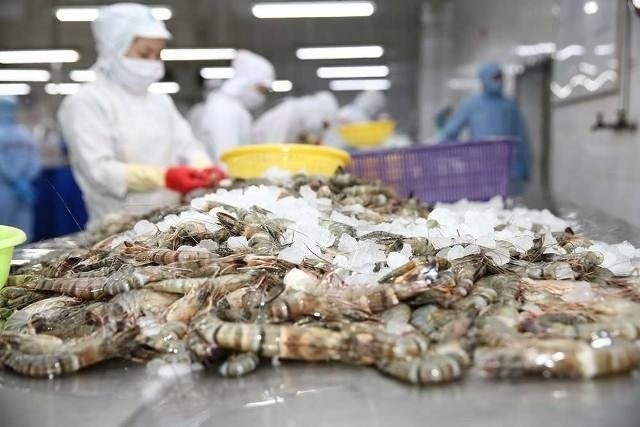 News
News
Shrimp exports recover
After facing a gloomy situation, Vietnam's shrimp exports are gradually recovering with orders from importers increasing again. Besides, large value contracts were also signed, mainly from importers from the US, Japan, EU, China and Korea.
According to Mr. Ho Quoc Luc, Chairman of the Board of Directors of Sao Ta Food Joint Stock Company, shrimp exports with a recovery trend can be clearly seen in July 2023 when Sao Ta's sales reached 21.3. million USD, equivalent to the same period last year, but up 18% compared to June 2023.
“In the third quarter of this year, seafood businesses are on the upswing in the hope that they will partially compensate for the recent shortfall in sales. However, an increase in sales is only a good sign, but it is not necessarily sustainable," said Ho Quoc Luc.
Mr. Truong Dinh Hoe - General Secretary of the Vietnam Association of Seafood Exporters and Producers (Vasep) said that, based on the consumption of markets, as well as cultural and festive conditions of countries, the The US and China are the hope for Vietnamese shrimp in the last months of 2023.
Currently, cold storages in the US and Europe are dwindling. US importers, retailers and wholesalers will begin to consider increasing imports again. This will drive shrimp prices higher, and it looks like shrimp prices are now bottoming out. Shrimp consumption for year-end festivals is also expected to increase. The supply of container ships is in a favorable state.
 |
| Shrimp exports seek to increase competitiveness |
For the Chinese market , Vietnam's shrimp exports to China in the first half of this year reached $239 million, down 19% over the same period. However, from June, shrimp exports to China recorded an increase over the same period last year, up 19% to $59 million.
According to the Vietnam Association of Seafood Exporters and Producers, there are three positive factors affecting shrimp exports: One is the decrease in inventories in import markets due to cooling inflation; Second, the demand for orders increases to serve the year-end festival season and finally, the supply is stable when countries like Ecuador, Malaysia... end the main shrimp harvest.
Facing positive signals from the market and the stable supply ability of businesses, Vasep forecast that, although not reaching the same turnover as last year, shrimp exports this year may reach over 3 billion USD, equal to the previous level. pandemic.
Solving the high cost bottleneck
Although the market showed positive signals, the fact that market demand, raw shrimp prices and export prices all went down, inflation increased, and strong competition with rival suppliers made shrimp exports. Our country continues to face many difficulties.
According to shrimp industry experts, Ecuadorian shrimp sold for $1.20/kg made a profit, while Vietnamese shrimp sold at $5/kg to make a profit. This makes Vietnamese shrimp less competitive compared to other countries.
Explaining the cause of this situation, Mr. Le Van Quang, Chairman of the Board of Directors of Minh Phu Seafood Corporation, said that the success rate of shrimp farming in Vietnam is currently only about 30% (much lower than other countries). competitors from India and Ecuador), making Vietnamese shrimp farming costs twice as high as Ecuador and more than 30% compared to India, making it difficult for Vietnamese shrimp to compete with competitors.
According to Mr. Quang, when the success rate of shrimp farming is increased, the story of farmers accessing high-cost feed prices will be resolved. Because farmers do not currently have the security to pay for the lack of food, while the risk of shrimp farming is very large, they have to buy through intermediaries, causing the selling price to go up very high.
"Food agents also reserve the possibility of getting money from the sale, so the new price was pushed to 30,000-40,000 VND/kg, much higher than the price we approached", Mr. Quang explained .
Mr. Truong Dinh Hoe, General Secretary of the Vietnam Association of Seafood Exporters and Producers (VASEP), acknowledged that one of the major problems facing the Vietnamese shrimp industry in general and the Mekong Delta in particular today. The production cost of raw shrimp is high because the success rate is low, only about 40%.
“Obviously, we have to find out where the cause is, maybe from poor quality seed that makes the success rate drop a lot, causing farmers to have to "re-raise" many times to get raw materials. for export,” said Mr. Hoe.
The current cost of feed is also an issue that needs to be focused on solving so that farmers can access a more reasonable price, instead of having to bear huge costs from the circulation system, making farming difficult. shrimp did not achieve the desired effect.
Obviously, when the price of shrimp feed is pulled down, production costs will decrease. At that time, the competitiveness of the Vietnamese shrimp industry will be better, especially when the deep processing level of Vietnamese shrimp enterprises is already very good.
“In terms of competition, it is clear that Vietnam is a country with an advantage in value-added products, while competitors are still focusing on products that are raw products, so we still can be sold, even though the price is higher ,” explained Mr. Hoe.
Mr. Hoe also cited that, out of a total of 5.5 billion USD of processed shrimp products imported by countries around the world, Vietnam alone accounted for 1.5 billion USD, the highest among major exporting countries today. such as: Ecuador, India, China. “That shows, Vietnam's processing level has met. However, besides the optimization of processing advantages, Vietnam needs to take into account the story of long-term cost reduction in order to maintain the competitiveness of the shrimp industry.
When the "bottlenecks" in the industry are resolved, the Vietnamese shrimp will gradually assert its position. Thereby, it will "conquer" markets and achieve the export target of 10 billion USD in the future.